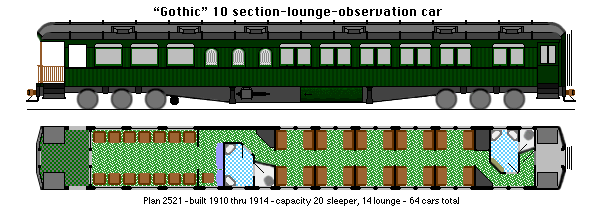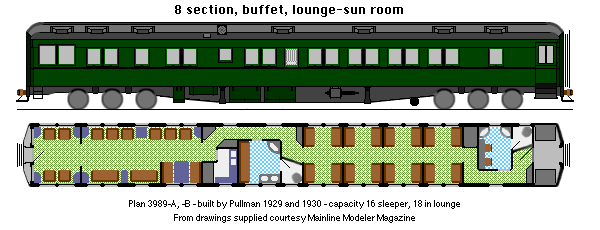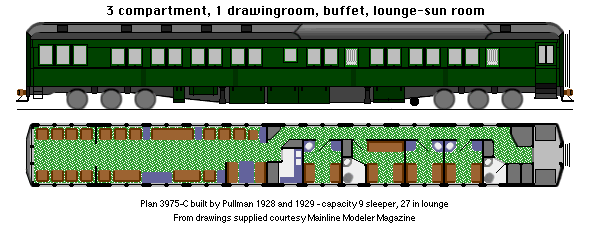
Content provided by Those Classic Trains

The 10 section-lounge-obs is a basic car that is used on a variety of secondary trains. The design actually dates from the Varnish period and continues into the Heavyweight period with several variations of the Plan 2521 (shown) and early Plan 3521 variants (the later Plan 3521s are enclosed sun room cars).
Note the large open platform area at left. At a time when passenger trains loped along at a comfortable 40 MPH or so, it was a popular practice to take a folding chair out on the rear deck and watch the scenery flow by. This particular car is called a "four-poster" due to the vertical struts on the corners of the observation platform (a design feature of a few of the early steel Gothic cars).
The deck is paved with diamond grid cast rubber sheeting which comes in a number of color combinations: the most popular being green and black. The cover plates over the rear stairwells are plain sheet steel. Due to its popularity, the vestibule area has been extended back several feet into the carbody, creating room for perhaps a dozen people. Two open windows are provided to give a better view, although these have generally been glassed in since then.
The lounge right forward of this has large windows in the end to give a good view in inclement weather. The room is lined with comfortable chairs and at the forward end are the traditional book case and writing desk. The car is carpeted throughout with Pullman's dark green fern pattern carpeting.
Note, too, that there are no buffet facilities, and that the sleeping accommodations are all open sections. The restrooms are modest sized, but adequate. This is a car intended for the less well known trains that handle the bread-and-butter regional and accommodation trade.

The 3-2 Lounge Obs is the most popular of the general service open platform cars. The observation car is traditionally ladies country, just as the baggage-club car is men's territory. The single large ladies restroom doubles as a lounge. Right next to it, at the head of the car (at right) is a rarity in the Standard Era: a shower. Note that what goes around, comes around: there is no men's restroom.
Again, there is no buffet. Dining services are traditionally a money loser, and Pullman generally limits its meal service to the tavern in the baggage-club car. In a few cases, custom cars built for a particular road have buffet facilities. But for the most part, Pullman leaves the railroads to pick up the losses of meal service in their diners.
At left, the observation platform has shrunk. What was a pleasant ride at 40 mph has turned into a tornadic experience as train speeds are increasing. Even as these cars are being built, the enclosed solariums are coming into use; the two types being built side by side at Pullman. Interestingly, some railroads - notably the Ann Arbor and the Wabash - have continued the open platform cars in preference to the newer solariums, while other roads have pushed aggressively to replace them.
This configuration provides a good selection of mid to high end sleeping accommodations. Cars of this type are used on some of the very finest Premiere trains - such as the "Crescent", shown here. They may also provide the top accommodations on a lesser train of section cars and/or Coach services.

Even before the Crash of 1929, the railroads had been experimenting with several new concepts. One is the enclosed observation lounge equipped with oversized windows - known generally as a "sun room". Passenger trains are now whipping along at a relentless mile-a-minute pace, which makes the rear platform a very uncomfortable spot, indeed. At these speeds, the vacuum of the train's passing sucks up dirt and debris and plasters them all over the rear of the train - and anyone sitting in the open there.
Another new concept is multi-application cars. The day of the purely revenue or non-revenue car is passing. To keep your passengers these days, one must offer better amenities and greater convenience. Case in point is the spread of buffet and cafe facilities. Having a buffet right in the car makes a light meal far more convenient. Buffet service is also more economical and, as it has only a two man crew, the economic burden to the railroad is not so great. Another virtue is that the buffets take some of the load off the diner; making that service more attractive; allowing the diner to be dropped from lightly traveled runs; or forestalling the need to assign second diners on larger trains.
These Plan 3989 cars are one of the results of this evolution. Essentially, they are an updated version of the Plan 2521s. The lounge area, at left, is roughly the same size and layout (the "sun room" occupying the former open platform). Windows are set into the rear of the carbody to provide an all round view.
At right, one set of sections has been sacrificed to provide a buffet and enlarged restroom spaces. Note that the Gentleman's Room (center) is also a smoking area while the Ladies has a vanity table.
These cars are very similar to the Plan 4020 " - Club" series sleeper-buffet-lounge and, like those cars, often serve as midtrain lounges. With the growing trend of combining several shrunken trains into one and cutting sections in and out as needed, the Plan 3989, Plan 4020 and similar cars often act as the tail car for these detached sections.

The ultimate expression of the Heavyweight tail car are these 3-1-buffet-sun rooms. Note that the lounge area takes up half of the total carbody and includes a buffet. To meet the increasing demand for public accommodations, amenities in these lounges include meal and beverage service, air conditioning, radio, a secretary and the best Stewards.
Further forward, sleeping accommodations include three compartments (the one next to the buffet is normally used by the Conductor and Pullman Representative) and a full drawingroom. Where trains have varying classes of accommodations, the observation car has traditionally had the best of the lot. This is especially true on these cars, who cater to the social elite.
These cars represent the most advanced thinking in Heavyweight observation car design. Several batches were constructed for Premiere service on various roads, but further production of the large lounge types has been curtailed by the Great Depression. Some of these have been rebuilt into Betterment semi-streamlined cars (see "Some Special Cars - Betterment Cars" in the Topic index).
The Pullman roster has seen a grand total of 109 Gothic observation cars (some of which have been rebuilt into standard obs) and some 511 Heavyweights over the years: not all being in service at once. These represent 33 Plans (some with several sub types). If you compare this with the roughly 25,000 steel cars on the combined rosters, you can see that only a small percentage of trains have observation cars.
Only a few types have been constructed in quantity, most being assigned to the General Service pool, thus showing up in a number of places. Quantities of these common Plan types (as shown above) include:
More typically, observation cars are built in small batches for specific assignments; their numbers ranging from 1 to a dozen. Some interesting specimens of these observation cars include:
Refer to "Free Downloads" for a summary of Pullman car types.
| Home Site Map Search Contact |
North East Rails © Clint Chamberlin. |